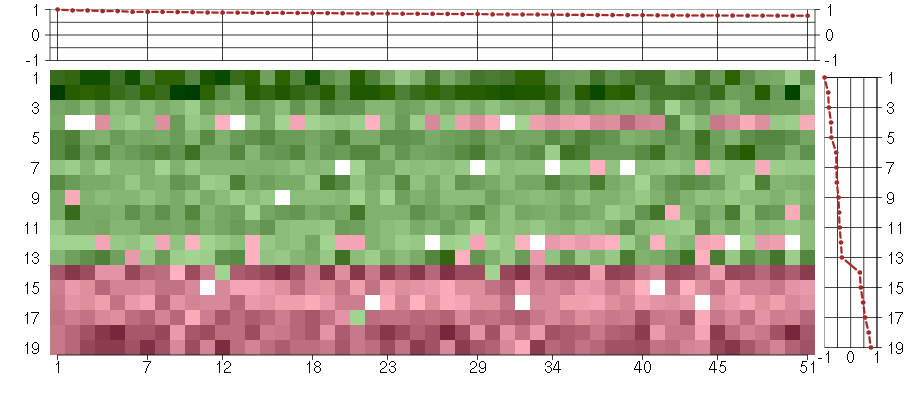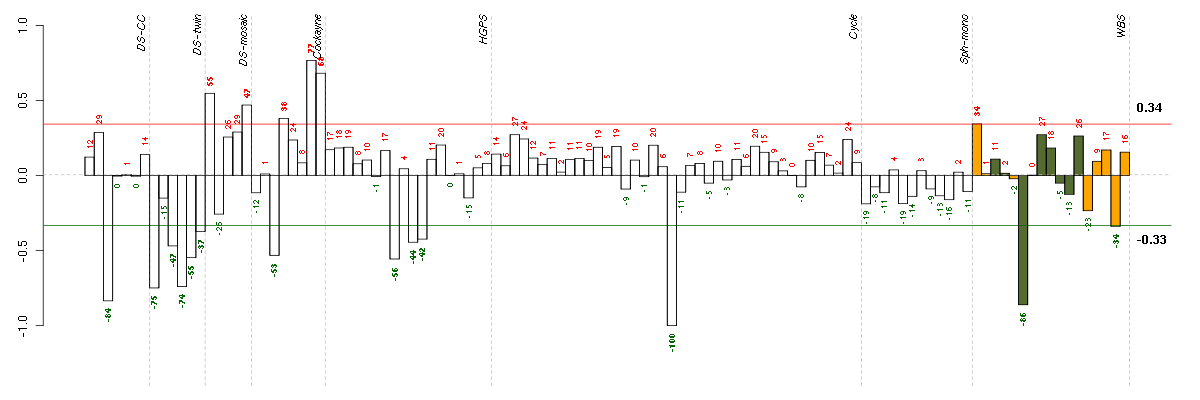



Under-expression is coded with green,
over-expression with red color.

vesicle-mediated transport
The directed movement of substances, either within a vesicle or in the vesicle membrane, into, out of or within a cell.
transport
The directed movement of substances (such as macromolecules, small molecules, ions) into, out of, within or between cells, or within a multicellular organism.
post-Golgi vesicle-mediated transport
The directed movement of substances from the Golgi to other parts of the cell, including organelles and the plasma membrane, mediated by small transport vesicles.
biological_process
Any process specifically pertinent to the functioning of integrated living units: cells, tissues, organs, and organisms. A process is a collection of molecular events with a defined beginning and end.
cellular process
Any process that is carried out at the cellular level, but not necessarily restricted to a single cell. For example, cell communication occurs among more than one cell, but occurs at the cellular level.
intracellular transport
The directed movement of substances within a cell.
Golgi vesicle transport
The directed movement of substances into, out of or within the Golgi apparatus, mediated by vesicles.
localization
Any process by which a cell, a substance, or a cellular entity, such as a protein complex or organelle, is transported to, and/or maintained in a specific location.
establishment of localization
The directed movement of a cell, substance or cellular entity, such as a protein complex or organelle, to a specific location.
cellular localization
Any process by which a substance or cellular entity, such as a protein complex or organelle, is transported to, and/or maintained in, a specific location within or in the membrane of a cell.
establishment of localization in cell
The directed movement of a substance or cellular entity, such as a protein complex or organelle, to a specific location within, or in the membrane of, a cell.
all
This term is the most general term possible
establishment of localization
The directed movement of a cell, substance or cellular entity, such as a protein complex or organelle, to a specific location.
cellular localization
Any process by which a substance or cellular entity, such as a protein complex or organelle, is transported to, and/or maintained in, a specific location within or in the membrane of a cell.
establishment of localization in cell
The directed movement of a substance or cellular entity, such as a protein complex or organelle, to a specific location within, or in the membrane of, a cell.
vesicle-mediated transport
The directed movement of substances, either within a vesicle or in the vesicle membrane, into, out of or within a cell.
intracellular transport
The directed movement of substances within a cell.
Golgi vesicle transport
The directed movement of substances into, out of or within the Golgi apparatus, mediated by vesicles.

plasma membrane
The membrane surrounding a cell that separates the cell from its external environment. It consists of a phospholipid bilayer and associated proteins.
membrane
Double layer of lipid molecules that encloses all cells, and, in eukaryotes, many organelles; may be a single or double lipid bilayer; also includes associated proteins.
integral to membrane
Penetrating at least one phospholipid bilayer of a membrane. May also refer to the state of being buried in the bilayer with no exposure outside the bilayer. When used to describe a protein, indicates that all or part of the peptide sequence is embedded in the membrane.
integral to plasma membrane
Penetrating at least one phospholipid bilayer of a plasma membrane. May also refer to the state of being buried in the bilayer with no exposure outside the bilayer.
cellular_component
The part of a cell or its extracellular environment in which a gene product is located. A gene product may be located in one or more parts of a cell and its location may be as specific as a particular macromolecular complex, that is, a stable, persistent association of macromolecules that function together.
cell
The basic structural and functional unit of all organisms. Includes the plasma membrane and any external encapsulating structures such as the cell wall and cell envelope.
oncostatin-M receptor complex
A heterodimeric receptor for the cytokine oncostatin-M (OSM). In humans the receptor complex is made up of the gene products gp130 and OSMR-beta.
intrinsic to membrane
Located in a membrane such that some covalently attached portion of the gene product, for example part of a peptide sequence or some other covalently attached moiety such as a GPI anchor, spans or is embedded in one or both leaflets of the membrane.
intrinsic to plasma membrane
Located in the plasma membrane such that some covalently attached portion of the gene product, for example part of a peptide sequence or some other covalently attached moiety such as a GPI anchor, spans or is embedded in one or both leaflets of the membrane.
macromolecular complex
A stable assembly of two or more macromolecules, i.e. proteins, nucleic acids, carbohydrates or lipids, in which the constituent parts function together.
protein complex
Any macromolecular complex composed of two or more polypeptide subunits, which may or may not be identical. Protein complexes may have other associated non-protein prosthetic groups, such as nucleotides, metal ions or carbohydrate groups.
receptor complex
Any protein complex that undergoes combination with a hormone, neurotransmitter, drug or intracellular messenger to initiate a change in cell function.
membrane part
Any constituent part of a membrane, a double layer of lipid molecules that encloses all cells, and, in eukaryotes, many organelles; may be a single or double lipid bilayer; also includes associated proteins.
plasma membrane part
Any constituent part of the plasma membrane, the membrane surrounding a cell that separates the cell from its external environment. It consists of a phospholipid bilayer and associated proteins.
cell part
Any constituent part of a cell, the basic structural and functional unit of all organisms.
all
This term is the most general term possible
cell part
Any constituent part of a cell, the basic structural and functional unit of all organisms.
membrane part
Any constituent part of a membrane, a double layer of lipid molecules that encloses all cells, and, in eukaryotes, many organelles; may be a single or double lipid bilayer; also includes associated proteins.
plasma membrane part
Any constituent part of the plasma membrane, the membrane surrounding a cell that separates the cell from its external environment. It consists of a phospholipid bilayer and associated proteins.
oncostatin-M receptor complex
A heterodimeric receptor for the cytokine oncostatin-M (OSM). In humans the receptor complex is made up of the gene products gp130 and OSMR-beta.
intrinsic to plasma membrane
Located in the plasma membrane such that some covalently attached portion of the gene product, for example part of a peptide sequence or some other covalently attached moiety such as a GPI anchor, spans or is embedded in one or both leaflets of the membrane.
integral to plasma membrane
Penetrating at least one phospholipid bilayer of a plasma membrane. May also refer to the state of being buried in the bilayer with no exposure outside the bilayer.
oncostatin-M receptor complex
A heterodimeric receptor for the cytokine oncostatin-M (OSM). In humans the receptor complex is made up of the gene products gp130 and OSMR-beta.

| Id | Pvalue | ExpCount | Count | Size |
|---|---|---|---|---|
| miR-320/320abcd | 4.869e-02 | 3.157 | 13 | 377 |
ADAM10ADAM metallopeptidase domain 10 (214895_s_at), score: 0.76 ASPHaspartate beta-hydroxylase (205808_at), score: 0.81 ATP13A3ATPase type 13A3 (219558_at), score: 0.9 ATP6V1AATPase, H+ transporting, lysosomal 70kDa, V1 subunit A (201971_s_at), score: 0.82 CBFBcore-binding factor, beta subunit (206788_s_at), score: 0.77 CDV3CDV3 homolog (mouse) (213548_s_at), score: 1 CLIC4chloride intracellular channel 4 (201559_s_at), score: 0.77 COPAcoatomer protein complex, subunit alpha (214336_s_at), score: 0.96 CPDcarboxypeptidase D (201942_s_at), score: 0.91 CYP51A1cytochrome P450, family 51, subfamily A, polypeptide 1 (216607_s_at), score: 0.87 DAZAP2DAZ associated protein 2 (212595_s_at), score: 0.83 DDX3XDEAD (Asp-Glu-Ala-Asp) box polypeptide 3, X-linked (201211_s_at), score: 0.94 DHX9DEAH (Asp-Glu-Ala-His) box polypeptide 9 (212105_s_at), score: 0.94 ERLIN1ER lipid raft associated 1 (202444_s_at), score: 0.78 EXOC5exocyst complex component 5 (218748_s_at), score: 0.79 FN1fibronectin 1 (214701_s_at), score: 0.84 GNA13guanine nucleotide binding protein (G protein), alpha 13 (206917_at), score: 0.78 GNSglucosamine (N-acetyl)-6-sulfatase (203676_at), score: 0.91 GTF2Igeneral transcription factor II, i (210892_s_at), score: 0.91 HP1BP3heterochromatin protein 1, binding protein 3 (220633_s_at), score: 0.78 HSPA4heat shock 70kDa protein 4 (211016_x_at), score: 0.81 IL6STinterleukin 6 signal transducer (gp130, oncostatin M receptor) (204864_s_at), score: 0.86 KPNA4karyopherin alpha 4 (importin alpha 3) (209653_at), score: 0.83 LMAN1lectin, mannose-binding, 1 (203294_s_at), score: 0.87 MAP3K2mitogen-activated protein kinase kinase kinase 2 (221695_s_at), score: 0.83 MAP3K7IP2mitogen-activated protein kinase kinase kinase 7 interacting protein 2 (210284_s_at), score: 0.84 MAPK1mitogen-activated protein kinase 1 (208351_s_at), score: 0.76 MAT2Amethionine adenosyltransferase II, alpha (200769_s_at), score: 0.85 MAXMYC associated factor X (210734_x_at), score: 0.88 MBNL2muscleblind-like 2 (Drosophila) (205018_s_at), score: 0.76 NOTCH2Notch homolog 2 (Drosophila) (210756_s_at), score: 0.76 OSMRoncostatin M receptor (205729_at), score: 0.8 PAFAH1B1platelet-activating factor acetylhydrolase, isoform Ib, alpha subunit 45kDa (211547_s_at), score: 0.83 PCDHGA11protocadherin gamma subfamily A, 11 (211876_x_at), score: 0.87 PHTF2putative homeodomain transcription factor 2 (217097_s_at), score: 0.88 PICALMphosphatidylinositol binding clathrin assembly protein (215236_s_at), score: 0.86 PRPF4BPRP4 pre-mRNA processing factor 4 homolog B (yeast) (211090_s_at), score: 0.76 PRRX1paired related homeobox 1 (205991_s_at), score: 0.76 PTBP1polypyrimidine tract binding protein 1 (212016_s_at), score: 0.8 RAB5ARAB5A, member RAS oncogene family (206113_s_at), score: 0.96 RANBP2RAN binding protein 2 (201711_x_at), score: 0.77 SCAMP1secretory carrier membrane protein 1 (206667_s_at), score: 0.89 SCARB2scavenger receptor class B, member 2 (201647_s_at), score: 0.84 SNAP23synaptosomal-associated protein, 23kDa (214544_s_at), score: 0.82 SS18synovial sarcoma translocation, chromosome 18 (216684_s_at), score: 0.76 STIP1stress-induced-phosphoprotein 1 (212009_s_at), score: 0.78 TGFBR2transforming growth factor, beta receptor II (70/80kDa) (207334_s_at), score: 0.8 UBXN4UBX domain protein 4 (212008_at), score: 0.86 VAMP3vesicle-associated membrane protein 3 (cellubrevin) (201337_s_at), score: 0.79 WACWW domain containing adaptor with coiled-coil (219679_s_at), score: 0.88 YWHAZtyrosine 3-monooxygenase/tryptophan 5-monooxygenase activation protein, zeta polypeptide (200641_s_at), score: 0.76
| Id | sample | Experiment | ExpName | Array | Syndrome | Cell.line |
|---|---|---|---|---|---|---|
| E-TABM-263-raw-cel-1515486031.cel | 20 | 6 | Cycle | hgu133a2 | none | Cycle 1 |
| 5042_CNTL.CEL | 6 | 8 | WBS | hgu133plus2 | none | WBS 1 |
| ctrl c 08-03.CEL | 3 | 1 | DS-CC | hgu133a | none | DS-CC 3 |
| 1Twin.CEL | 1 | 2 | DS-twin | hgu133plus2 | Down | DS-twin 1 |
| 4Twin.CEL | 4 | 2 | DS-twin | hgu133plus2 | none | DS-twin 4 |
| E-GEOD-3860-raw-cel-1561690304.cel | 8 | 5 | HGPS | hgu133a | none | GMO8398C |
| 5CTwin.CEL | 5 | 2 | DS-twin | hgu133plus2 | Down | DS-twin 5 |
| E-GEOD-3407-raw-cel-1437949655.cel | 3 | 4 | Cockayne | hgu133a | none | CSB |
| 3Twin.CEL | 3 | 2 | DS-twin | hgu133plus2 | Down | DS-twin 3 |
| E-GEOD-3860-raw-cel-1561690344.cel | 10 | 5 | HGPS | hgu133a | none | GM00038C |
| E-GEOD-3860-raw-cel-1561690352.cel | 11 | 5 | HGPS | hgu133a | HGPS | AG11498 |
| 6Twin.CEL | 6 | 2 | DS-twin | hgu133plus2 | none | DS-twin 6 |
| F348_WBS.CEL | 16 | 8 | WBS | hgu133plus2 | WBS | WBS 1 |
| 10358_WBS.CEL | 1 | 8 | WBS | hgu133plus2 | WBS | WBS 1 |
| E-GEOD-3407-raw-cel-1437949704.cel | 4 | 4 | Cockayne | hgu133a | CS | eGFP |
| 47C.CEL | 5 | 3 | DS-mosaic | hgu133plus2 | Down mosaic | DS-mosaic 5 |
| 46A.CEL | 1 | 3 | DS-mosaic | hgu133plus2 | none | DS-mosaic 1 |
| E-GEOD-3407-raw-cel-1437949938.cel | 8 | 4 | Cockayne | hgu133a | none | CSB |
| E-GEOD-3407-raw-cel-1437949854.cel | 7 | 4 | Cockayne | hgu133a | CS | eGFP |
